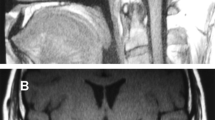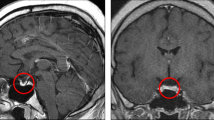Abstract
Introduction
Both duplications encompassing SOX3 and loss-of function mutations in SOX3 have been reported in a minor portion of X-linked isolated growth hormone deficiency (GHD) or combined pituitary hormone deficiency (CPHD) patients with or without mental retardation.
Patients and methods
We report a Japanese male patient with molecularly confirmed Kabuki syndrome who was found to have CPHD. We analyzed all coding exons and flanking introns of currently known nine genes responsible for CPHD by PCR-based sequencing.
Results
In this CPHD patient, we identified a novel hemizygous 21-base pair deletion, resulting in the loss of 7 alanine residues from polyalanine (PA) tracts of SOX3. The clinically and endocrinologically normal mother of the patient carried the same deletion in a heterozygous manner. In vitro experiments showed that the del 7A SOX3 had increased transactivation of the HESX1 promoter.
Conclusion
Our study provides additional evidence that deletion in PA tracts of SOX3 is associated with hypopituitarism. Female carriers of SOX3 PA tract deletions will show a broad phenotypic spectrum, ranging from clinically normal to CPHD.



Similar content being viewed by others
References
Collignon J, Sockanathan S, Hacker A, Cohen-Tannoudji M, Norris D, Rastan S, Stevanovic M, Goodfellow PN, Lovell-Badge R (1996) A comparison of the properties of SOX-3 with Sry and two related genes, Sox-1 and Sox-2. Development 122(2):509–520
Laumonnier F, Ronce N, Hamel BC, Thomas P, Lespinasse J, Raynaud M, Paringaux C, Van Bokhoven H, Kalscheuer V, Fryns JP, Chelly J, Moraine C, Briault S (2002) Transcription factor SOX3 is involved in X-linked mental retardation with growth hormone deficiency. Am J Hum Genet 71(6):1450–1455
Woods KS, Cundall M, Turton J, Rizotti K, Mehta A, Palmer R, Wong J, Chong WK, Al-Zyoud M, El-Ali M, Otonkoski T, Martinez-Barbera JP, Thomas PQ, Robinson IC, Lovell-Badge R, Woodward KJ, Dattani MT (2005) Over- and underdosage of SOX3 is associated with infundibular hypoplasia and hypopituitarism. Am J Hum Genet 76(5):833–849
Burkitt Wright EM, Perveen R, Clayton PE, Hall CM, Costa T, Procter AM, Giblin CA, Donnai D, Black GC (2009) X-linked isolated growth hormone deficiency: expanding the phenotypic spectrum of SOX3 polyalanine tract expansions. Clin Dysmorphol 18(4):218–221
Alatzoglou KS, Kelberman D, Cowell CT, Palmer R, Arnhold IJ, Melo ME, Schnabel D, Grueters A, Dattani MT (2011) Increased transactivation associated with SOX3 polyalanine tract deletion in a patient with hypopituitarism. J Clin Endocrinol Metab 96(4):685–690
Niikawa N, Matsuura N (1981) Kabuki make-up syndrome: a syndrome of mental retardation, unusual facies, large and protruding ears, and postnatal growth deficiency. J Pediatr 99(4):565–569
Kuroki Y, Suzuki Y, Chyo H, Hata A, Matsui I (1981) A new malformation syndrome of long palpebral fissures, large ears, depressed nasal tip, and skeletal anomalies associated with postnatal dwarfism and mental retardation. J Pediatr 99(4):570–573
Ng SB, Bigham AW, Buckingham KJ, Hannibal MC, McMillin MJ, Gildersleeve HI, Beck AE, Tabor HK, Cooper GM, Mefford HC, Lee C, Turner EH, Smith JD, Rieder MJ, Yoshiura K, Matsumoto N, Ohta T, Niikawa N, Nickerson DA, Bamshad MJ, Shendure J (2010) Exome sequencing identifies MLL2 mutations as a cause of Kabuki syndrome. Nat Genet 42(9):790–793
Niikawa N, Kuroki Y, Kajii T, Matsuura N, Ishikiriyama S, Tonoki H, Ishikawa N, Yamada Y, Fujita M, Umemoto H (1988) Kabuki make-up (Niikawa-Kuroki) syndrome: a study of 62 patients. Am J Med Genet 31(3):565–589
Handa Y, Maeda K, Toida M, Kitajima T, Ishimaru J, Nagai A, Oka N (1991) Kabuki make-up syndrome (Niikawa-Kuroki syndrome) with cleft lip and palate. J Craniomaxillofac Surg 19(3):99–101
Satoh M, Arakawa K, Yokoya S, Morooka K (1993) A case of Kabuki make-up syndrome associated with growth hormone deficiency. Clin Pediatr Endocrinol 2(1):13–16
Tawa R, Kaino Y, Ito T, Goto Y, Kida K, Matsuda H (1994) A case of Kabuki make-up syndrome with central diabetes insipidus and growth hormone neurosecretory dysfunction. Acta Paediatr Jpn 36(4):412–415
Devriendt K, Lemli L, Craen M, de Zegher F (1995) Growth hormone deficiency and premature thelarche in a female infant with kabuki makeup syndrome. Horm Res 43(6):303–306
Gabrielli O, Bruni S, Bruschi B, Carloni I, Coppa GV (2002) Kabuki syndrome and growth hormone deficiency: description of a case treated by long-term hormone replacement. Clin Dysmorphol 11(1):71–72
Allen RC, Zoghbi HY, Moseley AB, Rosenblatt HM, Belmont JW (1992) Methylation of HpaII and HhaI sites near the polymorphic CAG repeat in the human androgen-receptor gene correlates with X chromosome inactivation. Am J Hum Genet 51(6):1229–1239
Micale L, Augello B, Fusco C, Selicorni A, Loviglio MN, Silengo MC, Reymond A, Gumiero B, Zucchetti F, D’Addetta EV, Belligni E, Calcagnì A, Digilio MC, Dallapiccola B, Faravelli F, Forzano F, Accadia M, Bonfante A, Clementi M, Daolio C, Douzgou S, Ferrari P, Fischetto R, Garavelli L, Lapi E, Mattina T, Melis D, Patricelli MG, Priolo M, Prontera P, Renieri A, Mencarelli MA, Scarano G, della Monica M, Toschi B, Turolla L, Vancini A, Zatterale A, Gabrielli O, Zelante L, Merla G (2011) Mutation spectrum of MLL2 in a cohort of Kabuki syndrome patients. Orphanet J Rare Dis. 9(6):38–45
Hannibal MC, Buckingham KJ, Ng SB, Ming JE, Beck AE, McMillin MJ, Gildersleeve HI, Bigham AW, Tabor HK, Mefford HC, Cook J, Yoshiura K, Matsumoto T, Matsumoto N, Miyake N, Tonoki H, Naritomi K, Kaname T, Nagai T, Ohashi H, Kurosawa K, Hou JW, Ohta T, Liang D, Sudo A, Morris CA, Banka S, Black GC, Clayton-Smith J, Nickerson DA, Zackai EH, Shaikh TH, Donnai D, Niikawa N, Shendure J, Bamshad MJ (2011) Spectrum of MLL2 (ALR) mutations in 110 cases of Kabuki syndrome. Am J Med Genet A 155A(7):1511–1516
Paulussen AD, Stegmann AP, Blok MJ, Tserpelis D, Posma-Velter C, Detisch Y, Smeets EE, Wagemans A, Schrander JJ, van den Boogaard MJ, van der Smagt J, van Haeringen A, Stolte-Dijkstra I, Kerstjens-Frederikse WS, Mancini GM, Wessels MW, Hennekam RC, Vreeburg M, Geraedts J, de Ravel T, Fryns JP, Smeets HJ, Devriendt K, Schrander-Stumpel CT (2011) MLL2 mutation spectrum in 45 patients with Kabuki syndrome. Hum Mutat 32(2):2018–2025
Li Y, Bögershausen N, Alanay Y, Simsek Kiper PO, Plume N, Keupp K, Pohl E, Pawlik B, Rachwalski M, Milz E, Thoenes M, Albrecht B, Prott EC, Lehmkühler M, Demuth S, Utine GE, Boduroglu K, Frankenbusch K, Borck G, Gillessen-Kaesbach G, Yigit G, Wieczorek D, Wollnik B (2011) A mutation screen in patients with Kabuki syndrome. Hum Genet 136(6):715–724
Issaeva I, Zonis Y, Rozovskaia T, Orlovsky K, Croce CM, Nakamura T, Mazo A, Eisenbach L, Canaani E (2007) Knockdown of ALR (MLL2) reveals ALR target genes and leads to alterations in cell adhesion and growth. Mol Cell Biol 27(5):1889–1903
Acknowledgments
We thank the patient and his family for participation in this study. We thank Kazue Kinoshita for technical assistance. This work was supported by a Grant-in-Aid for the Health Science Research Grant for Research on Applying Health Technology [Jitsuyoka (Nanbyo)-Ippan-014 (23300102)] from the Ministry of Health, Labour and Welfare of Japan.
Conflict of interest
The authors have declared no conflicts of interest.
Author information
Authors and Affiliations
Corresponding author
Rights and permissions
About this article
Cite this article
Takagi, M., Ishii, T., Torii, C. et al. A novel mutation in SOX3 polyalanine tract: a case of kabuki syndrome with combined pituitary hormone deficiency harboring double mutations in MLL2 and SOX3 . Pituitary 17, 569–574 (2014). https://doi.org/10.1007/s11102-013-0546-5
Published:
Issue Date:
DOI: https://doi.org/10.1007/s11102-013-0546-5




